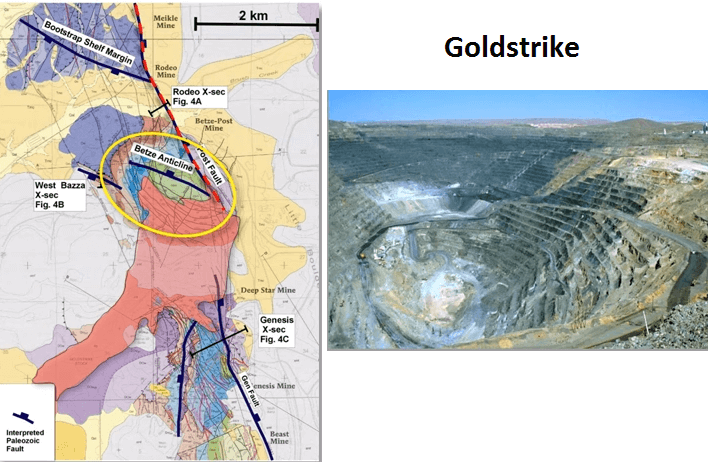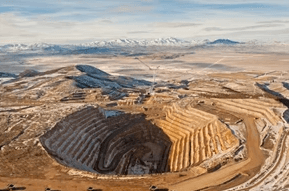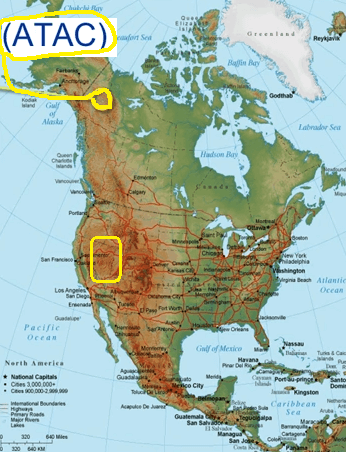

This section on Carlin Style Mineralisation Deposit Examples will give you a quick run through of a couple of actual Carlin deposits to give an idea of their characteristics; we will begin with Barrick’s goldstrike deposit, it’s in the north of the Carlin trend. Gold strike is the mother and father of Carlin deposits and is responsible for Barrick being the biggest gold producer in the world today. As you can see the geology exhibits a number of our targeting criteria. It’s hosted in dirty carbonate rocks in the lower plate located just under the Roberts Mountain thrust. It’s in an anticline in the hanging wall of the post fault and old fault that can be demonstrated to have been active during sedimentation 500 million years before the mineralization was introduced. There’s also next pre-existing intrusive that probably played a major role in structurally preparing the rocks for mineralizing fluids. Gold strike is just one of a cluster of deposits in this part of the Carlin trend. The deposited as I said is a monster and it produced 1.2 million oz. in 2010 alone at a production cost of over $410 an oz. So far more than 35,000,000 oz. have been extracted and they are still another 12.6 million oz. in reserves remaining however as with most sulfide operations in the Carlin trend the ore is refractory and it requires roasting or autoclave oxidation to release the gold.
The second example is Barrick’s Cortez Hills deposit which was discovered by (Inaudible 38:01) in 2002 and went into production in 2010 producing ore from both open pit and underground. It is on the Cortez trend as opposed to the Carlin trend towards the south of that line of deposits. This is a view of the deposit looking to the Southwest very early on in the exploration program it was completely blind buried under tens of meters of valley filled gravel. The deposit is likely to end up containing more than 15,000,000 oz. of gold. The location of Cortez Hills was identified by applying the targeting criteria described earlier. The deposit lies adjacent to the Cortez fault which began life as an extensional fault during the early sedimentation it was then inverted into a thrust fault during the antler orogeny and finally re-mobilized as an extension of fault again during the mineralization phase. The thrusting resulted in the formation of an anticline fold in the hanging wall of the fault which provides an ideal trap for the mineralizing fluids. That anticline strikes northwest rotated 45° from the normal north-south folding trend. Also during the anti-orogeny a large intrusive was in place nearby which helped with ground preparation, so I guess the discovery of the Cortez Hills allows us some confidence in the validity of the exploration model. This is a cutaway diagram looking towards the East showing the low-grade mineralization and drill holes near surface and the deep are shallowly plunged in high-grade zone that is being mined from underground. The pediment deposits is a shallow deposit also related to the Cortez fault.
 This is a recent photo of the new Cortez Hills open pit looking towards the northwest.
This is a recent photo of the new Cortez Hills open pit looking towards the northwest.
Virtually all Carlin deposits discovered to date are located in North Central Nevada however in 2010 ATAC resources discovered gold mineralization in the Yukon that has all the hallmarks of Carlin style mineralization. This is the discovery location.  ATAC’s Nadaleen mineralization is located in an anticline in a hanging wall of a regional scale fault it’s hosted by dirty limestones and the gold is very fine and associated with pyrite, augment and realgar. We don’t yet know the age of the mineralization but would not be surprised to learn that it is of a similar age to the Nevada mineralization and associated with extensional faulting seeing that occurred at the end of a long period of compression. So the hunting ground for Carlin deposits may have been dramatically expanded now.
ATAC’s Nadaleen mineralization is located in an anticline in a hanging wall of a regional scale fault it’s hosted by dirty limestones and the gold is very fine and associated with pyrite, augment and realgar. We don’t yet know the age of the mineralization but would not be surprised to learn that it is of a similar age to the Nevada mineralization and associated with extensional faulting seeing that occurred at the end of a long period of compression. So the hunting ground for Carlin deposits may have been dramatically expanded now.
Carlin deposits are very attracted to major mining companies:
- They can be very big and they are often high-grade as well they are indeed big elephants.
- They are hosted in dirty limestones in Nevada, this means mainly in the lower plate rocks and associated with long-lived crustal scale faults.
- The gold itself is to fine to see with the naked eye or to pan; the so-called micron gold.
- Carlin deposits can often be mined by open pit although this is less likely in the future and that means cheap mining and a low cut-off grade.
- Oxidized deposits usually have simple metallurgy and therefore cheaper extraction. Sulfide ore on the other hand is often refractory. There are no significant economic byproducts from Carlin deposits.
- Most Carlin deposits discovered to date occurred in Northern Nevada although there are deposits in Mexico, China and Argentina described as Carlin type. The recent discovery of unequivocal Carlin style mineralization in the Yukon throws open a whole new area for exploration however it’s too early to be able to say whether any other Yukon mineralization will prove to be economic
- Carlin deposits are not common and the easy ones have already been discovered. There are still only a relatively limited hunting ground and Carlin deposits are indeed wily elephant’s.
[/fusion_builder_column][/fusion_builder_row][/fusion_builder_container]
